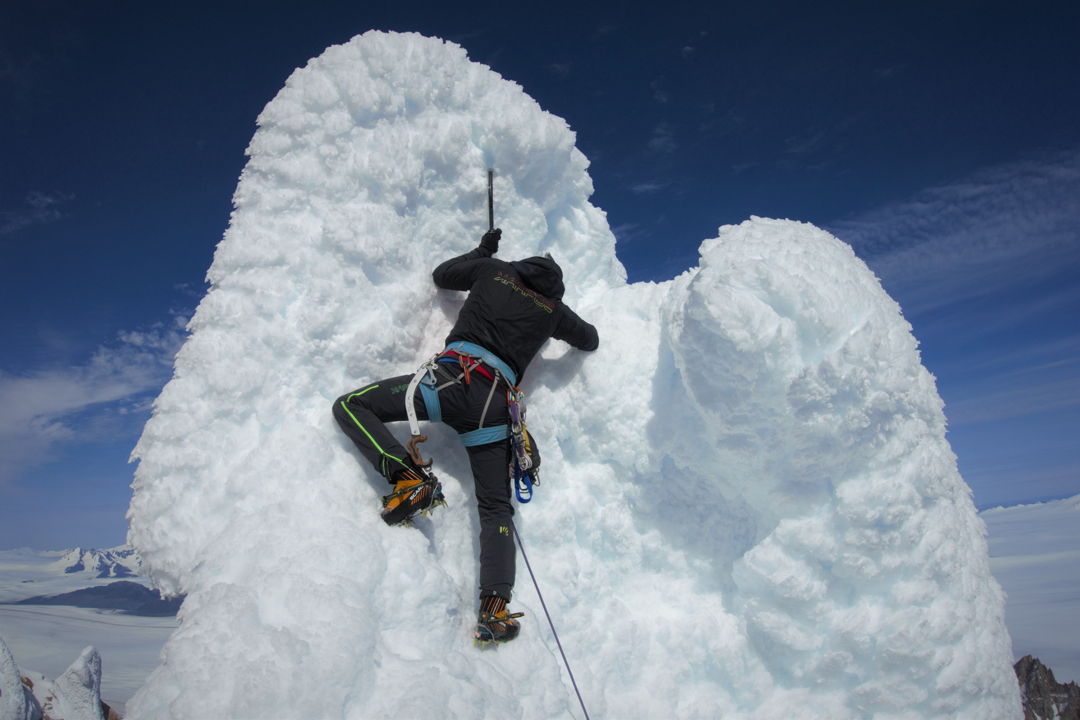Aguja Standhardt, North Face, Il Dado e’ Tratto; El Mocho, North Face, Jurassic Park; Aguja Poincenot, North Face, 40° Gruppo Ragni, First Free Ascent
Argentina, Southern Patagonia, Chaltén Massif
 I left Italy at the end of January 2020 with two longtime partners, Matteo Bernasconi and Matteo Pasquetto, heading south for an annual visit to the mountains that, for me, are simply the most beautiful in the world. We had a clear goal in mind: a line on Cerro Torre that I had attempted with Matteo Pasquetto the previous season.
I left Italy at the end of January 2020 with two longtime partners, Matteo Bernasconi and Matteo Pasquetto, heading south for an annual visit to the mountains that, for me, are simply the most beautiful in the world. We had a clear goal in mind: a line on Cerro Torre that I had attempted with Matteo Pasquetto the previous season.
Alpinists in Chaltén had waited weeks for the good weather to arrive. However, once it finally did, the final portion of our objective lay buried in a thick layer of ice. Adapting quickly, we decided to try a new route on Aguja Standhardt, one that I had imagined on previous visits to the Torre Valley. On February 5, we began by climbing the lower “slabs,” starting about 60m down and left from the bergschrund leading to Col Standhardt and 100m left of the route Festerville (Martin-O’Neill, 2000). After the first seven pitches, the quality of the climb was already very good and harder than expected; however, the best had yet to come.
The following day, we began with some technical crack action, and, after a boulder-like crux, reached a crazy-overhanging hand- and fist-jam corner. Due to the sustained physical effort, we decided to split the 100m corner into three separate pitches. Unfortunately, the last meters were filled with ice. Instead of abandoning our only number 4 cam, we placed one bail bolt, lowered to our anchor, and decided to aid a thin seam 6m to the right. Afterwards was another tricky pitch, followed by some easier ones along the left arête of Standhardt’s north face until the first summit. Reaching this point at 6 p.m., and knowing we could count on perfect weather, we opted for a luxurious bivy. We completed the route to the summit the next day, following the upper pitches of Festerville.

In retrospect, our bivouac was a bad choice. The descent down Exocet proved to be quite scary in high daytime temperatures. Nonetheless, from an objective point of view, the rock quality, climbing style, and position on our new route are tremendous—plus it’s waiting for a complete free ascent: Il Dado e’ Tratto (“The Die is Cast,” 600m, 7b A1).

A couple of weeks later, we were blessed with another window of good weather. This time we headed for the north face of Aguja Poincenot in the Fitz Roy group. Though not as famous as other features, the first route on this wall was opened in 1986 by fellow Ragni di Lecco climbers Daniele Bosisio, Mario Panzeri, Marco Della Santa, and Paolo Vitali. They called it 40° Gruppo Ragni (550m, 6a+ C2). After climbing and fixing our two ropes on the first pitches, we slept at the base of the route. On February 21, we were able to climb the whole route in a day. Both Matteo Pasquetto and I achieved our objective to free climb the route onsight. It’s a really good climb, which could become popular, as it’s always in the 5.10 and 5.11 range.
Our third and last climb for this season involved unfinished business on the north face of El Mocho. One year prior, Matteo Pasquetto and I had teamed up with Brette Harrington (USA) to attempt the very aesthetic lower pillar, left of the route Morbito (Nagato-Sato, 2017). The climb proved to be much harder than expected, and we didn’t have a large cam for the final offwidth cracks.
On February 28, Matteo Pasquetto and I managed to climb the route in very high winds. After the first four pitches (up to 7b), we chose a slightly different line than the prior year. So, for pitch five, there are two options: a sketchy string of peckers aided by Brette in 2019 (A2+) or, now, a mellower, but still tricky, flared crack and slab (C1). The final, 40m offwidth was the real killer of the route. After 25m of Yosemite-like climbing, I exploded, exhausted, with bleeding ankles and without a shred of energy left (C1).

Jurassic Park (320m, 7b C1) is an excellent climb, with some really cool, sustained overhanging crack pitches in the range of 5.11+/5.12. We finished our line as planned atop the pinnacle, however, one can reach the top of El Mocho by other existing routes.
– Matteo Della Bordella, Italy








